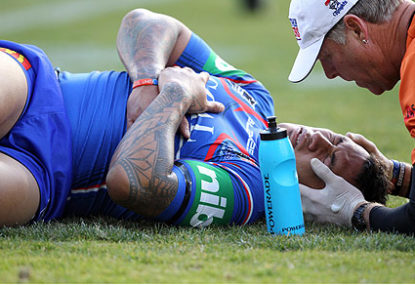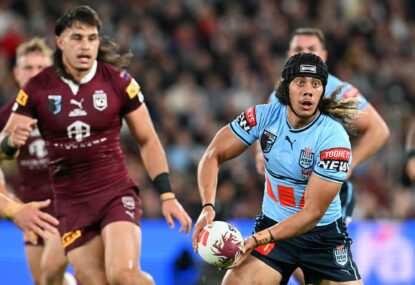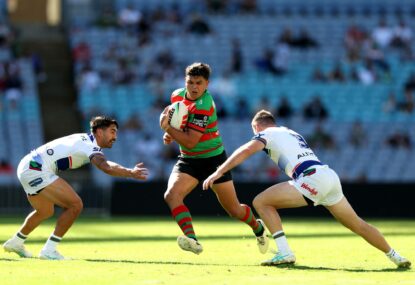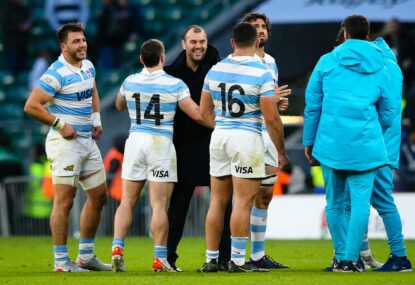Every time an NRL player is forced to leave a match after suffering an injury as a result of an act of foul play, there are howls of protest from the masses.
It’s unfair! Why does team X lose a player and team Y keep all of theirs?
With the apparent elimination of the send off, the howls have become even greater. However, I don’t think it is really that big an issue when you compare it with rugby league’s numerous other problems. But it appears as though the NRL has decided to listen to the protesters and is looking at a number of options to rectify the problem.
The leading solution is an 18th man that is allowed to enter the game should a player be removed due to an act of foul play. I can’t say I’m a huge fan. I might be in the minority, but I personally feel that the 17 you bring into a rugby league game should be the only 17 you use.
On top of this, the AFL is in the process of reviewing the substitute rule that they implemented in 2011. The substitute rule has been widely viewed as a disaster, more often than not he becomes a tactically selected player that is intentionally brought into the match sometime during the third quarter.
Admittedly it appears as though the NRL’s 18th man will only be able to enter the match due to an act of foul play or concussion, but it is still an extra player that shouldn’t be allowed to enter the match.
As a result of my dislike of the use of an 18th man, I have come up with a counter solution – a solution borrowed from the National Hockey League in America and Canada.
The NHL has a rule called a Match Penalty, if you deliberately injure, or attempt to injure, an opponent you will be ejected. Typically for an ejection to occur it must seem likely that the opposition player will not return for the remainder of the match. An eye for an eye, so to speak.
The Match Penalty ejection is also accompanied with a five-minute major penalty; your team will play the next five minutes with one less man than the opposition. Ice hockey also features a Game Misconduct rule, in which it is possible for a player to be ejected without their team playing shorthanded for a period of time.
So, if we translate all of this back to rugby league, a player who commits an act of foul play will be permanently removed from the match, their team may or may not play 10 minutes with 12 and they will be left with 16 players for the remainder of the match, the same number as their opposition.
Take the Tyson Frizell example from Round 6. Frizell would have been removed from the match and the Dragons would have spent 10 minutes playing with 12 men before a substitute came on to return the team to 13 players. However, they would have been left with just three players on the bench, the same number as the Bulldogs were left with.
In the end, both teams are left with equal numbers and one team can’t cry foul at being left with a disadvantage because of an act of foul play by the opposition.
There are a few possible hurdles to overcome with this system. The first is if a team deliberately picks a bad player and tells him to target the opposition’s best player, making sure he doesn’t make it past the opening five minutes. It is possible for this to happen, but unlikely for a number of reasons.
Firstly, the offending player will be suspended, so it is unsustainable in the long run to keep pulling up enforcers every week from reserve grade.
Secondly, I’m not advocating for the send off to be banned. It is an option and if the act of violence is so gregariously obvious, it should be used, leaving the offending team with just twelve players for the remainder of the game.
On top of this, there is likely to be the question about a player being removed from the game because the referees think the victim has been eliminated from the game, only for him to return 10 or 15 minutes later.
This is a legitimate concern, however with the new concussion laws the concern is diminished. Players who are concussed are not allowed to return to the field, thus there is less grey area for referees who are making this decision.
Furthermore, if the offending player is initially sent to the sin bin the referees have 10 minutes to potentially make sure that the victim isn’t returning.
If the player returns, or passes his concussion test, during this ten-minute period the offending player can be informed that his match is not over. Such a system is not perfect, but it is a possible compromise if players and officials are unwilling to risk removing a player from the game due to an inaccurate initial diagnosis.
Whenever the NRL announces that they are conducting a review of current rules, it always seems as though they have a desired outcome in mind. In this case, it is an 18th man who can only be used in the result of a concussion or act of foul play that rules in a player taking no more part in the race.
I implore the NRL to look further left field and look at some alternative options before deciding on a decision. You never know, you might just find a solution that is even better than the one they initially planned on implementing.




































































































